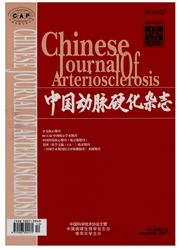

 中文摘要:
中文摘要:
目的研究沙利度胺对的动脉粥样硬化病变形成的抑制作用。方法新西兰免分为3组,每组13只。正常饮食组给予普通饮食;高脂组给予2%的高胆固醇饮食;高脂加药组给予2%的高胆固醇饮食+20mg/kg沙利度胺,2个月后宰杀动物,取整条主动脉行苏丹Ⅳ染色检测斑块面积,油红O染色和HE染色检测斑块的病变程度,油红O染色检测肝脏内脂质蓄积情况,不同时间点采血,检测总胆固醇、低密度脂蛋白、高密度脂蛋白和甘油三酯等血脂指标水平,ELISA方法检测血液中肿瘤坏死因子α水平。结果(1)高脂饮食喂养新西兰兔2个月后,总胆固醇、低密度脂蛋白和高密度脂蛋白等指标较正常饮食组明显升高。苏丹Ⅳ染色高脂组有36.7%±4.3%红染面积,而正常正常饮食组基本上见不到红染区。油红O染色高脂纽血管内膜有大量被染成黄色的脂滴存在,而在正常饮食组几乎没有。HE染色高脂组可以看到明显的动脉粥样硬化斑块存在,而正常饮食组没有。这些指标都表明动脉粥样硬化模型制作成功。(2)与高脂组比较,高脂加药组病变面积明显减少,动脉粥样硬化斑块内泡沫细胞数量以及脂质含量都明显减少。沙利度胺能显著减轻动脉粥样硬化病变程度。(3)与高脂组比较,高脂加药组甘油三酯、总胆固醇、低密度脂蛋白和高密度脂蛋白等血脂指标差异无显著性。沙利度胺不影响血液脂质水平。(4)与高脂组比较,高脂加药组肝脏脂质含量差别不大。沙利度胺不影响肝脏脂质代谢。(5)与高脂组比较,高脂加药组肿瘤坏死因子α水平明显下降。结论沙利度胺具有抑制动脉粥样硬化形成的作用,其机制与脂质代谢调节无关,而可能主要是与沙利度胺能下调肿瘤坏死因子α的表达有关。
 英文摘要:
英文摘要:
Aim To Study the effect of Thalidomide inhibiting atherosclerogenesis. Methods Thirty nine New Zealand rabbits were divided into three groups equally. Normal diet group; High cholesterol diet group, including 2% cholesterol ; High cholesterol diet + 20 mg/kg Thalidomide (Thd) group. After 2 months, the animals were killed. The whole aorta was stained with Sudan Ⅳ, and atherosclerotic plaque size was measured. The atherosclerotic lesion degree was checked after the plaque slice was stained with oil red O and HE. The accumulation of lipid in liver was studied by oil red O stain. The contents of total cholesterol, low density lipoprotein, High density lipoprotein, and Triglyc, eride were detected at different time points. The level of tumor necrosis factor alpha was measured by ELISA. Results ( 1 ) The atherosclerotic animal model was founded successfully by high cholesterol diet feeding for two months, which was confirmed by the level of blood total cholesterol, LDL, HDL, TG, and Sudan IV stain size, and oil red O stained lipid content, and HE stained lesion size on atherosclerotic plaque slice. (2) Compared with high cholesterol group, the atherosclerotic plaque size on the vascular wall in Thd group was lower remarkably, the number of foam cells and macrophages was decreased, and the content of lipid in plaque was decreased also. All of these indicated that Thd may reduce the degree of atherosclerotic plaque lesion. (3) Compared with high cholesterol group, the content of cholesterol, LDL, HDL, TG in Thd group had no statistical difference, which indicated that Thd had no effect on the metabolism of serum lipid. ( 4 ) Compared with high cholesterol group, the content of lipid in liver in Thd group had no difference, which indicated that Thd had no effect on the metabolism of liver lipid. (5) Compared with high cholesterol group, the level of TNF-α in Thd group was decreased remarkably. Conclusion Thd can inhibit atherosclerogenesis in rabbits with high lipid diet,which is no relative
 同期刊论文项目
同期刊论文项目
 同项目期刊论文
同项目期刊论文
 期刊信息
期刊信息
